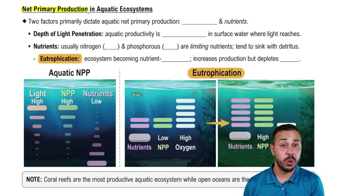Table of contents
- 1. Introduction to Biology2h 40m
- 2. Chemistry3h 40m
- 3. Water1h 26m
- 4. Biomolecules2h 23m
- 5. Cell Components2h 26m
- 6. The Membrane2h 31m
- 7. Energy and Metabolism2h 0m
- 8. Respiration2h 40m
- 9. Photosynthesis2h 49m
- 10. Cell Signaling59m
- 11. Cell Division2h 47m
- 12. Meiosis2h 0m
- 13. Mendelian Genetics4h 41m
- Introduction to Mendel's Experiments7m
- Genotype vs. Phenotype17m
- Punnett Squares13m
- Mendel's Experiments26m
- Mendel's Laws18m
- Monohybrid Crosses16m
- Test Crosses14m
- Dihybrid Crosses20m
- Punnett Square Probability26m
- Incomplete Dominance vs. Codominance20m
- Epistasis7m
- Non-Mendelian Genetics12m
- Pedigrees6m
- Autosomal Inheritance21m
- Sex-Linked Inheritance43m
- X-Inactivation9m
- 14. DNA Synthesis2h 27m
- 15. Gene Expression3h 20m
- 16. Regulation of Expression3h 31m
- Introduction to Regulation of Gene Expression13m
- Prokaryotic Gene Regulation via Operons27m
- The Lac Operon21m
- Glucose's Impact on Lac Operon25m
- The Trp Operon20m
- Review of the Lac Operon & Trp Operon11m
- Introduction to Eukaryotic Gene Regulation9m
- Eukaryotic Chromatin Modifications16m
- Eukaryotic Transcriptional Control22m
- Eukaryotic Post-Transcriptional Regulation28m
- Eukaryotic Post-Translational Regulation13m
- 17. Viruses37m
- 18. Biotechnology2h 58m
- 19. Genomics17m
- 20. Development1h 5m
- 21. Evolution3h 1m
- 22. Evolution of Populations3h 52m
- 23. Speciation1h 37m
- 24. History of Life on Earth2h 6m
- 25. Phylogeny2h 31m
- 26. Prokaryotes4h 59m
- 27. Protists1h 12m
- 28. Plants1h 22m
- 29. Fungi36m
- 30. Overview of Animals34m
- 31. Invertebrates1h 2m
- 32. Vertebrates50m
- 33. Plant Anatomy1h 3m
- 34. Vascular Plant Transport2m
- 35. Soil37m
- 36. Plant Reproduction47m
- 37. Plant Sensation and Response1h 9m
- 38. Animal Form and Function1h 19m
- 39. Digestive System10m
- 40. Circulatory System1h 57m
- 41. Immune System1h 12m
- 42. Osmoregulation and Excretion50m
- 43. Endocrine System4m
- 44. Animal Reproduction2m
- 45. Nervous System55m
- 46. Sensory Systems46m
- 47. Muscle Systems23m
- 48. Ecology3h 11m
- Introduction to Ecology20m
- Biogeography14m
- Earth's Climate Patterns50m
- Introduction to Terrestrial Biomes10m
- Terrestrial Biomes: Near Equator13m
- Terrestrial Biomes: Temperate Regions10m
- Terrestrial Biomes: Northern Regions15m
- Introduction to Aquatic Biomes27m
- Freshwater Aquatic Biomes14m
- Marine Aquatic Biomes13m
- 49. Animal Behavior28m
- 50. Population Ecology3h 41m
- Introduction to Population Ecology28m
- Population Sampling Methods23m
- Life History12m
- Population Demography17m
- Factors Limiting Population Growth14m
- Introduction to Population Growth Models22m
- Linear Population Growth6m
- Exponential Population Growth29m
- Logistic Population Growth32m
- r/K Selection10m
- The Human Population22m
- 51. Community Ecology2h 46m
- Introduction to Community Ecology2m
- Introduction to Community Interactions9m
- Community Interactions: Competition (-/-)38m
- Community Interactions: Exploitation (+/-)23m
- Community Interactions: Mutualism (+/+) & Commensalism (+/0)9m
- Community Structure35m
- Community Dynamics26m
- Geographic Impact on Communities21m
- 52. Ecosystems2h 36m
- 53. Conservation Biology24m
48. Ecology
Introduction to Ecology
Problem 7c
Textbook Question
The open ocean and tropical rain forests contribute the most to Earth's net primary production because a. both have high rates of net primary production. b. both cover huge surface areas of Earth. c. nutrients cycle fastest in these two ecosystems. d. the ocean covers a huge surface area and the tropical rain forest has a high rate of production.
 Verified step by step guidance
Verified step by step guidance1
Understand the concept of net primary production (NPP), which is the rate at which all the plants in an ecosystem produce net useful chemical energy.
Consider the factors that contribute to high NPP, such as availability of sunlight, water, and nutrients, as well as the area covered by the ecosystem.
Evaluate the characteristics of the open ocean and tropical rain forests in terms of these factors.
Analyze the options given: (a) focuses on rates of NPP, (b) considers the surface area, (c) discusses nutrient cycling, and (d) combines the ideas of surface area and rate of production.
Determine which option best explains why these two ecosystems contribute the most to Earth's NPP by linking the characteristics of these ecosystems to the factors that enhance NPP.
Recommended similar problem, with video answer:
 Verified Solution
Verified SolutionThis video solution was recommended by our tutors as helpful for the problem above
Video duration:
2mPlay a video:
Was this helpful?
Key Concepts
Here are the essential concepts you must grasp in order to answer the question correctly.
Net Primary Production (NPP)
Net Primary Production (NPP) refers to the amount of organic matter produced by photosynthetic organisms, minus the organic matter consumed by respiration. It is a crucial measure of ecosystem productivity, indicating how much energy is available to support the food web. High NPP is typically found in ecosystems with abundant sunlight and nutrients, such as tropical rainforests and open oceans.
Recommended video:
Guided course

Primary Production in Aquatic Ecosystems
Ecosystem Surface Area
The surface area of an ecosystem plays a significant role in its overall productivity. Larger ecosystems, like the open ocean, can support vast populations of photosynthetic organisms, leading to higher total production. In contrast, smaller ecosystems may have limited production potential, regardless of their NPP rates. Thus, both the size and productivity of an ecosystem are important for understanding its contribution to global NPP.
Recommended video:
Guided course

Surface Area to Volume Ratio
Nutrient Cycling
Nutrient cycling refers to the movement and exchange of organic and inorganic matter back into the production of living matter. In ecosystems like tropical rainforests and the open ocean, efficient nutrient cycling supports high rates of primary production. However, while nutrient cycling is important, it is not the sole factor determining NPP; the combination of surface area and production rates is also critical.
Recommended video:
Guided course

Soil Nutrients

 2:54m
2:54mWatch next
Master What is Ecology? with a bite sized video explanation from Jason Amores Sumpter
Start learningRelated Videos
Related Practice































































































